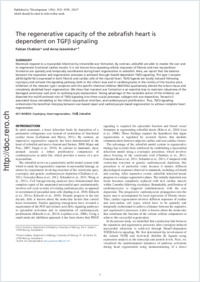The regenerative capacity of the zebrafish heart is dependent on TGFβ signaling
- Chablais, Fabian Department of Biology, University of Fribourg, Switzerland
- Jaźwińska, Anna Department of Biology, University of Fribourg, Switzerland
-
18.04.2012
Published in:
- Development. - 2012, vol. 139, p. 1921-1930
English
Mammals respond to a myocardial infarction by irreversible scar formation. By contrast, zebrafish are able to resolve the scar and to regenerate functional cardiac muscle. It is not known how opposing cellular responses of fibrosis and new myocardium formation are spatially and temporally coordinated during heart regeneration in zebrafish. Here, we report that the balance between the reparative and regenerative processes is achieved through Smad3-dependent TGFβ signaling. The type I receptor alk5b (tgfbr1b) is expressed in both fibrotic and cardiac cells of the injured heart. TGFβ ligands are locally induced following cryoinjury and activate the signaling pathway both in the infarct area and in cardiomyocytes in the vicinity of the trauma zone. Inhibition of the relevant type I receptors with the specific chemical inhibitor SB431542 qualitatively altered the infarct tissue and completely abolished heart regeneration. We show that transient scar formation is an essential step to maintain robustness of the damaged ventricular wall prior to cardiomyocyte replacement. Taking advantage of the reversible action of the inhibitor, we dissected the multifunctional role of TGFβ signaling into three crucial processes: collagen-rich scar deposition, Tenascin C-associated tissue remodeling at the infarct-myocardium interface, and cardiomyocyte proliferation. Thus, TGFβ signaling orchestrates the beneficial interplay between scar-based repair and cardiomyocyte-based regeneration to achieve complete heart regeneration.
- Faculty
- Faculté des sciences et de médecine
- Department
- Département de Biologie
- Language
-
- English
- Classification
- Biological sciences
- License
- License undefined
- Identifiers
-
- RERO DOC 29069
- DOI 10.1242/dev.078543
- Persistent URL
- https://folia.unifr.ch/unifr/documents/302308
Statistics
Document views: 94
File downloads:
- cha_rcz.pdf: 252
